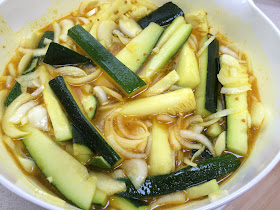Hello
again.
Yes, it was
a long, cold winter. But, once again Restoration Farm is in full swing and
bursting with life. And, I am in a constant state of anxiety trying to manage
the overwhelming amount of produce I lug home every week. When you join a CSA,
the battle over spoilage is constant (why does that seemingly indestructible
kale seem to wilt so quickly?) along with a healthy helping of guilt served up
whenever that carefully raised local food withers, shrivels or develops a
rash.
But now, I
have the answer to my seasonal dilemma.
Pickling.
I know
certain wags among you will assume I'm drowning my angst by hitting the liquor cabinet,
but I’m referring to pickling of the more homespun variety. A simple brine of vinegar, sugar, salt,
garlic and spices can pack some amazing flavor, and summer produce just soaks
it all in.
Apparently,
a penchant for pickling might be a genetic thing. A long time ago, Long Island was a bit of a
pickle paradise, with “salting stations” dotting the landscape. HJ Heinz even operated a pickling factory in
Hicksville, Long Island in the late 1800s.
Most
pickling can be accomplished without using a boiling water canner. These are technically known as “refrigerator pickles.” They aren’t shelf stable, but last about a
month in the refrigerator. The only potential downside is the kitchen counters can get a little tacky from all that sugar and vinegar.
I start with
two varieties. I slice up the first of
the summer zucchini into spears and pickle it in a brine of turmeric and
mustard seed. You simply slice up the
vegetables (the zucchini needs to sit for about an hour in a salted water
bath), simmer the brine a few minutes, cover the vegetables, let the mixture
cool and then refrigerate. A clean up note: Clorox Cleanup does a bang up job of removing turmeric stains from the kitchen counter.
The idea of
infusing carrots with brine intrigues me, so I get both orange and white carrots
to work with. The orange carrots are
from Restoration Farm, and the white carrots are from Terry Farm in Orient
Point, one of the oldest operating farms on Long Island. The brine is infused with dill.
The zucchini
recipe can be found here. My zucchini
was various sizes so I chose to cut it all into spears. The carrot recipe can be found here.
I’m thrilled
because there’s a ready-to-eat side dish in the refrigerator waiting for me
each night so the need to turn on the stove in the summer is negligible. I’m now researching pickled beets, although
the recipe I have in mind does require processing in a boiling water
canner.
Along with
the carrots and zucchini, there’s been another project marinating this past
winter. More on that soon, as well as the story of a familiar (although never
glimpsed) face from the past with a healthy appetite, who is ready to take a
bite out of New York once again.
©2015 T.W.
Barritt All Rights Reserved









My very favorite pickles are dill pickles that sit in brine on the countertop for two days before getting packed and stored in the fridge. You can stop the pickling process at any point, depending on how crispy or how sour you want your pickles. Kirby cukes, fresh dill from the garden or farmers market, and some pickling spice do the trick, no canning required.
ReplyDeleteI definitely know what you mean about not being able to keep up with the produce! I don't have a CSA subscription but when I go to the farmers market regularly I can't seem to resist buying more than I can eat! Pickling sounds like an interesting idea!
ReplyDelete